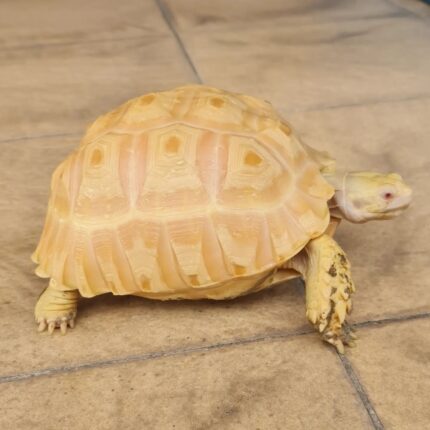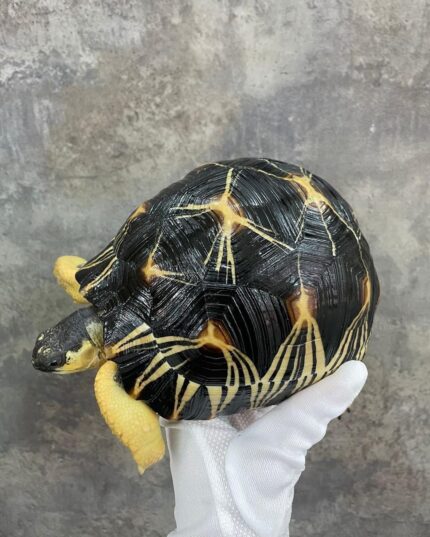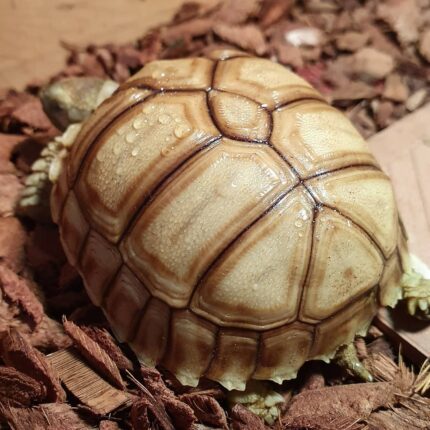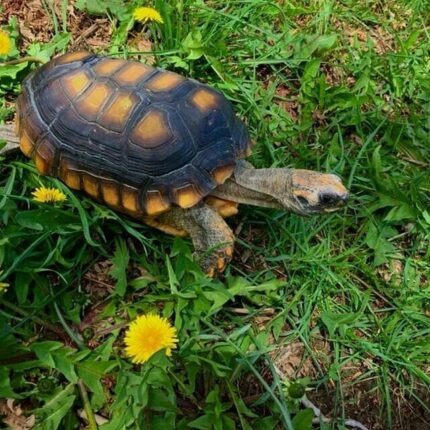
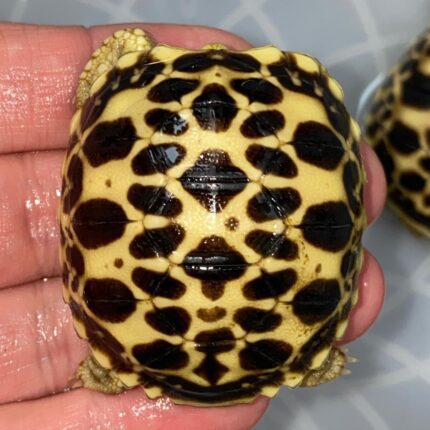
Golden Greek tortoise
$214.00 – $429.00 / 0.00252 Ƀ
Golden Greek tortoise is not a proper species name. Any yellowish colored Greek tortoise (Testudo graeca) can be called a golden Greek tortoise regardless of its origin or subspecies, but most golden Greeks are thought to be part of the Middle Eastern Greek tortoise group.
In captivity, golden Greek tortoises from various, unknown locations have been bred with each other. This complicates their identification and care in captivity. Some golden Greeks are hardier, while others are more sensitive. You will have to observe your goldens to find out what conditions, especially temperature and humidity levels, they tolerate and like best.
Goldens as pets
My golden Mesopotamian Greek tortoises (Testudo graeca terrestris) are adorable, spunky mini tortoises. Some of mine do indeed have beautiful golden yellow shells, but most are more beige in color. Their shell patterns are not as ornate as those of star tortoises, but their shells seem to shine and glow outdoors in the sunshine or indoors under UV lights. Lovely little gems. Gold or not. :0)
Captive-bred and long-term captive golden Greeks are quite robust as pets and can tolerate a reasonable range of temperatures. They are rather easy keepers, as far as tortoises go, and generally do well in captivity. As adults, they are easy to breed when well cared for, and their babies are extremely cute.
On the other hand, newly imported golden Greek tortoises can be delicate and often need extra care and pampering at first. They can carry heavy parasite loads and/or be riddled with infections that need veterinary treatment. Sadly, many imports have perished. However, if successfully acclimated to captive conditions, they will thrive when kept appropriately. This acclimation period can last 1-2 years, or even longer.
Temperamental and unpredictable fresh imports are not recommended for inexperienced tortoise keepers, but captive-bred golden Greeks are a great choice for new tortoise hobbyist who have done proper research on their care (like one should do for any species). Captive-bred goldens are fairly easy to find and their prices are reasonable.
Caution
Golden Greek tortoises are said to be susceptible to respiratory problems if kept too cold, too humid, or too wet. Sometimes shellrot may also be a problem if kept too wet. Since goldens can be of different subspecies and come from various habitat areas, their hardiness in captivity will differ. Some goldens cannot tolerate high humidity or cool temperatures, while others do quite well in cooler temperatures as long as the conditions are dry.
Buying captive-bred golden Greeks is highly recommended over imports, but if your tortoise is a new import, take take him to a vet for exam, fecal test, and possibly a blood test. New Greek imports may carry infections and need deworming for both worms and protozoa. Without care, they may struggle and pass away.
About care advice
There is no specific one best way to care for tortoises, but many good ways to do it. A lot depends on your specific circumstances, like your location and climate, severity of seasons, your housing setups, and so on. Advice below provides some starting points in golden Greek tortoise care; they are not exact requirements. Observe your tortoises and adjust your care as needed.
Food
Food
- Greek tortoises are herbivorous
- See the tortoise diet pages
Supplements
- Recommendations for supplements vary
- See the tortoise supplements page
Water
- Always provide fresh drinking water
- Use a very shallow water dish for hatchlings
- Give 10-60 min soaks (baths) in warm, shallow water
- Change the bath water as needed to keep it warm and clean
- Tiny hatchlings should be bathed daily to ensure adequate drinking of water
- Preferably, soak adults at least 1-2 times a month to help with hydration
-
Outdoor housing
- Outdoors is best for Greeks, weather permitting
- Allow as much time as possible outdoors in the natural sun
- Even babies can spend time outdoors on warm days, but always provide shady areas and cool drinking water
- Some keepers raise their young Greeks outdoors exclusively, with or without heated houses depending on the climate
- Outdoor enclosures must be well secured to prevent escaping; goldens are excellent climbers and good diggers
- Outdoor enclosure for adults should be large; golden Greeks can be quite energetic during their active periods and like to have space to run around
- Best to bring indoors during rain and cold temperatures below 60-65 °F (15.6-18.3 °C), unless they have a warm and dry shelter they can retire to
- Many keepers in Arizona, southern California, and other warm climates keep their golden Greeks outdoors year round with or without additional heat depending on their tortoises’ robustness
- My goldens, other than babies and yearlings, live outdoors year round; I keep babies indoors their first winter
- At first, all my goldens had heated outdoor houses, but nowadays only my original, imported goldens do; my captive-bred ones seem to do well in my area without additional heat as long as they have soil and hay filled, waterproof shelters to protect them from the cold and wet winter weather
- Whether to brumate (hibernate) your goldens depends on their hardiness level, your climate, and your preference
- See the tortoise housing pages
| Age |
cb Hatchlings ,cb Well started baby ,cb yearling |
|---|



